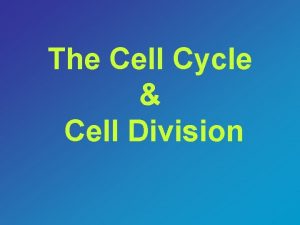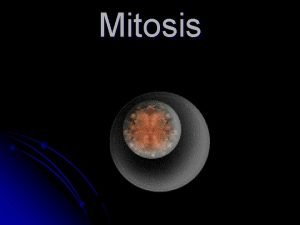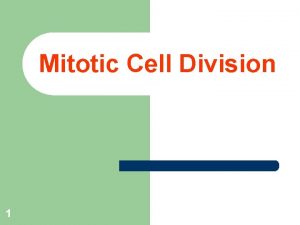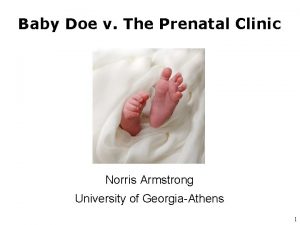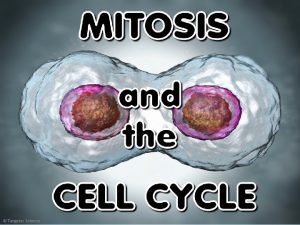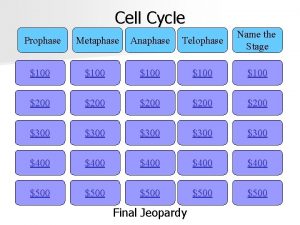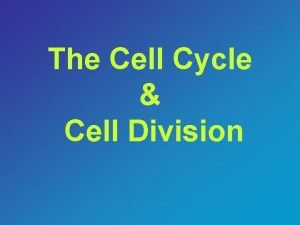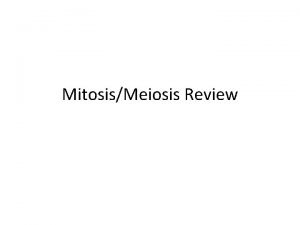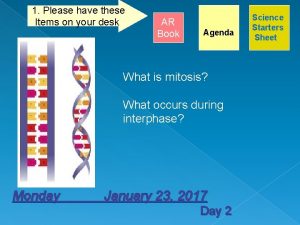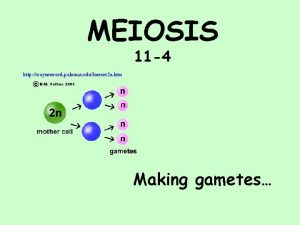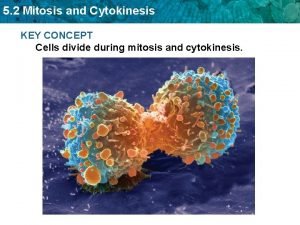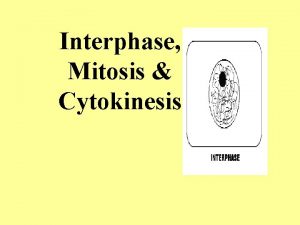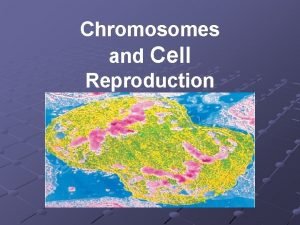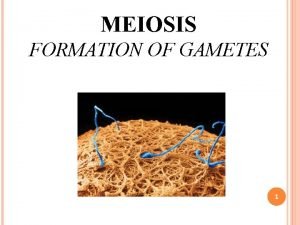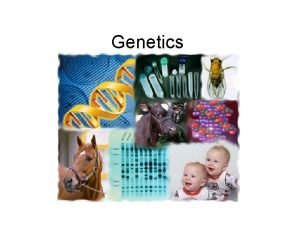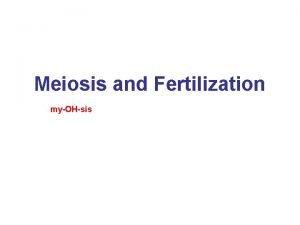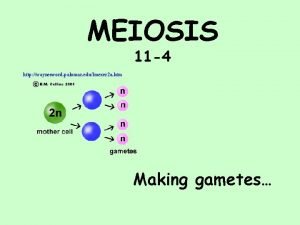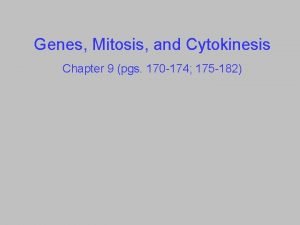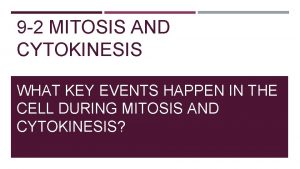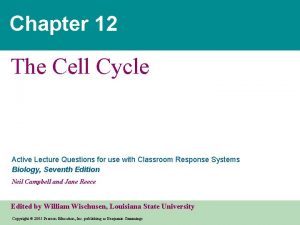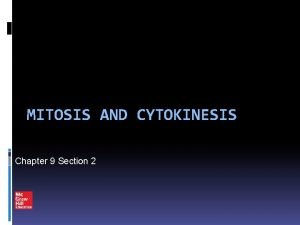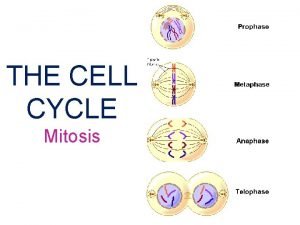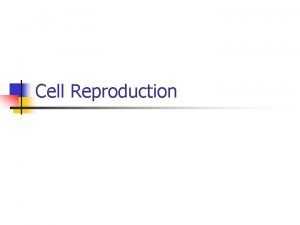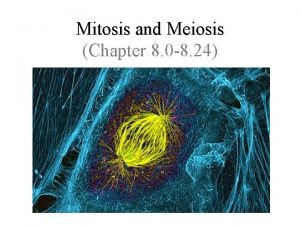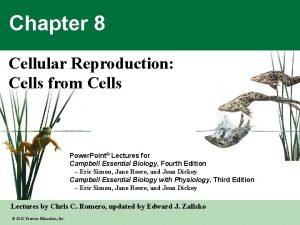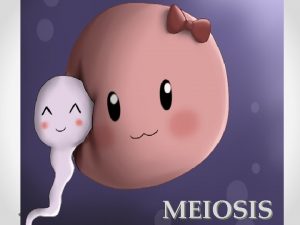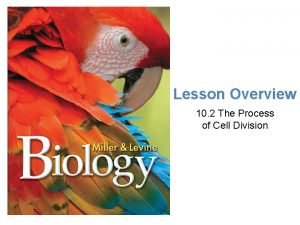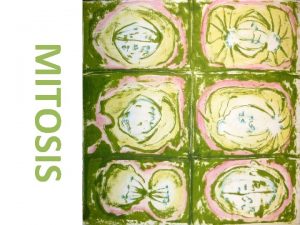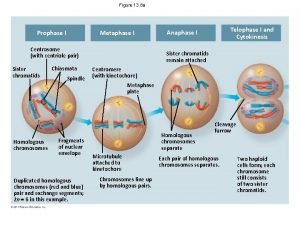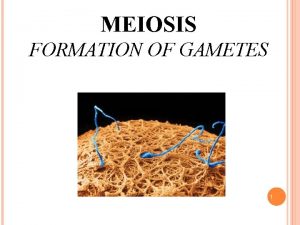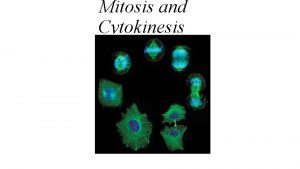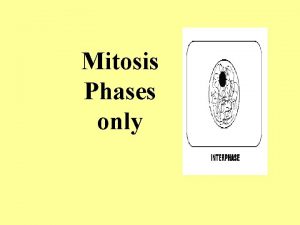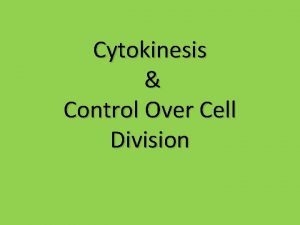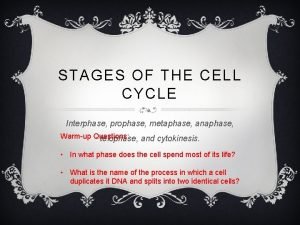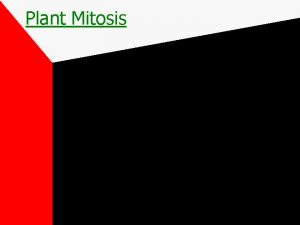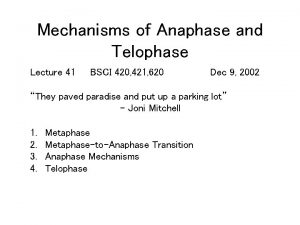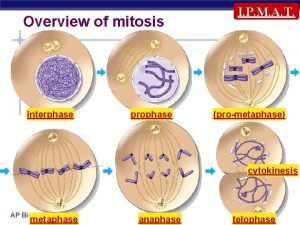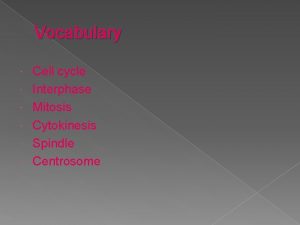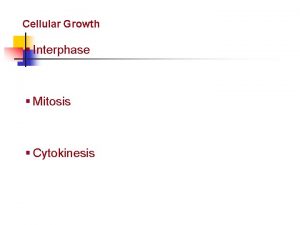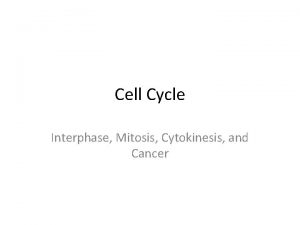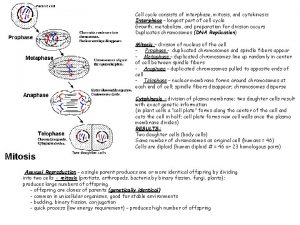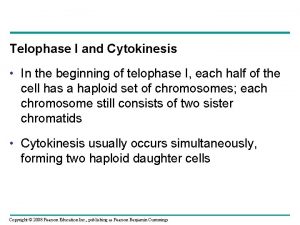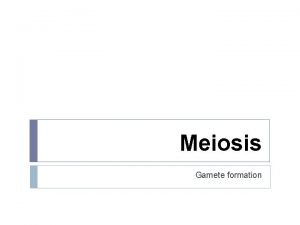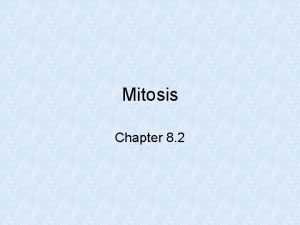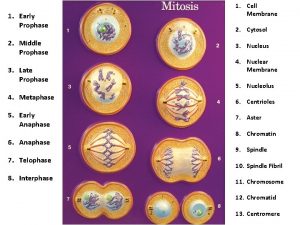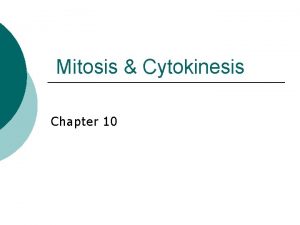Mitosis Review Interphase Prophase Metaphase Anaphase Telophase Cytokinesis



































- Slides: 35

Mitosis Review • • • Interphase Prophase Metaphase Anaphase Telophase Cytokinesis MITOSIS

Meiosis produces ”gametes”, with half the number of chromosomes diploid cells are reduced to haploid cells Diploid (2 n) Haploid (n) If Meiosis did not occur the chromosome number in each new generation would double…. The offspring would die.

MEIOSIS Interphase – replication Meiosis II Prophase I Metaphase I Anaphase I Telophase I Prophase II Metaphase II Anaphase II Telophase II

Prophase I - Synapsis Homologous chromosomes sister chromatids Tetrad sister chromatids

Homologous Chromosomes (because a homologous pair consists of 4 chromatids it is called a “Tetrad”) eye color locus hair color locus Paternal Maternal

Meiosis I • Prophase I - homologous chromosomes pair – Crossing over! - creates variation (diversity) nonsister chromatids chiasmata: site of crossing over Tetrad


Meiosis I • Metaphase I – Homologous pair line up at center (tetrad) – INDEPENDENT ASSORTMENT OCCURS: 1. Orientation of homologous pair is random 2. **Variation**

• The Key Difference Between Mitosis and Meiosis is the Way Chromosomes Uniquely Pair and Align in Meiosis Mitosis The first (and distinguishing) division of meiosis

Meiosis I • Anaphase I – Homologous pairs move to opposite sides of cell • Telophase I/Cytokinesis – Cell divides


Meiosis II • • Prophase II - no DNA replication!!! Metaphase II Anaphase II Telophase II/Cytokinesis


Mitosis vs. Meiosis 1. Number of Cells – Mitosis creates 2 identical cells – Meiosis creates 4 individual cells 2. Number of chromosomes – Mitosis creates cells with 46 chromosomes (2 n – diploid) – Meiosis creates cells with 23 chromosomes (n – haploid) 3. Locations – Mitosis – somatic (“normal”) cells – Meiosis – gametes (sex) cells

Meiosis Mitosis Chromosome Number: Reduced by half (haploid) Remains the same (diploid) Pairing of Homologues: Yes No Function: sexual reproduction Cellular (asexual) Reproduction; general growth and repair of the body #of Divisions: 2 1 #of Cells produced: 4 2 Creates: Sex cells (Gametes) Somatic Cells Crossing Over: Yes No Genetically: different identical


Importance of Meiosis • Genetic Variation • Random distribution of chromosomes • Chromosomes are passed to offspring independently of each other



Fertilization • The fusion of a sperm and egg to form a zygote • A zygote is a fertilized egg n=23 egg sperm n=23 2 n=46 zygote

Asexual reproduction • • Asexual reproduction involves a single parent. genetically identical offspring All prokaryotes and some eukaryotes can be very rapid – allows them to crowd out other organisms that reproduce more slowly

Three types of asexual Binary fission - a parent cell splits into two identical daughter cells Fragmentation - a parent organism breaks into pieces and each piece develops into a new organism Budding - a parent cell forms a bubble-like bud. The bud stays attached to the parent cell while it grows and develops. When the bud is fully developed, it breaks away from the parent cell and forms a new organism.

Sexual Reproduction • • • involves two parents produce gametes Gametes are haploid cells two gametes unite is called fertilization The fertilized cell is a zygote. A zygote is diploid cell

Sexual vs. Asexual Reproduction Asexual Sexual • Organisms inherit all chromosomes from single parent • Chromosomes from 2 parents • Takes more energy • Genetic variation – Genetically identical • • Little energy No mate needed Good for stable env’t Bacteria – Good for changing env’t • Most animals/organisms Why reproduce sexually? Greater chance of beneficial mutations • Crossing over, random assortment

How many cells are at the end of meiosis? How many chromosomes are in each cell? Agenda for Monday April 25 th 1. Review meiosis/Go over worksheet 2. Asexual/sexual reprod.

http: //www. sumanasinc. com/webcontent/animations/content/meiosis. html

http: //wps. prenhall. com/esm_freeman_biosci_1/7/1948/498784. cw/index. html

List 2 ways genetic variation occurs in meiosis. Agenda for Tuesday April 26 th 1. Quiz 2. Review stuff

Whiteboard Questions 1. If a cell has 40 chromosomes, how many are in each cell at the end of meiosis? 2. Mitosis? 3. T/F: Mitosis creates 2 different cells 4. T/F: A difference between meiosis & mitosis is that meiosis occurs in gametes and mitosis occurs in somatic cells. 5. What is 1 way variation is provided in meiosis?

IS the following description meiosis or mitosis? 1. Two cell divisions 2. Occurs in gametes 3. Half the original chromosomes 4. Homologous Chromosomes pair up 5. Creates identical cells 6. Four daughter cells 7. Same #of chromosomes in each cell at end

Meiosis Two cell divisions Half the original chromosomes Homologous Chromosomes pair up Cytokinesis Four daughter cells 46 Chromosomes at end Mitosis

Check the correct box for each description Meiosis 1. Two cell divisions 2. Occurs in gametes 3. Half the original chromosomes 4. Homologous Chromosomes pair up 5. Creates identical cells 6. Four daughter cells 7. Same #of chromosomes at end Mitosis

1. Prophase I 2. Metaphase I 3. Anaphase I 4. Telophase/Cytokinesis I

3. Anaphase II 1. Prophase II Cells from Meiosis I 2. Metaphase II 4. Telophase II /Cytokinesis II

2 n 4 n 46 Interphase/ DNA replicates 96 2 n Meiosis II n 23 46 46 n n n 23 23 23
 Anaphase
Anaphase Prophase metaphase anaphase telophase
Prophase metaphase anaphase telophase Prophase metaphase anaphase telophase
Prophase metaphase anaphase telophase Prophase metaphase anaphase telophase
Prophase metaphase anaphase telophase Telophase diagram
Telophase diagram What comes before anaphase
What comes before anaphase Http://www.cellsalive.com
Http://www.cellsalive.com Label the following pictures
Label the following pictures Telophase
Telophase Meiosis vs mitosis
Meiosis vs mitosis Interphase to cytokinesis
Interphase to cytokinesis Interphase to cytokinesis
Interphase to cytokinesis What are spindle fibers made of
What are spindle fibers made of Meiosis
Meiosis Polar body
Polar body Nucleotide consists of
Nucleotide consists of Metaphase 1 vs metaphase 2
Metaphase 1 vs metaphase 2 Anaphase 1 of meiosis
Anaphase 1 of meiosis Meiosis va mitosis
Meiosis va mitosis Metaphase
Metaphase Chapter 9 section 2 mitosis and cytokinesis
Chapter 9 section 2 mitosis and cytokinesis Mitosis and cytokinesis images in order
Mitosis and cytokinesis images in order Cytokinesis usually but not always follows mitosis
Cytokinesis usually but not always follows mitosis Chapter 9 section 2: mitosis and cytokinesis answer key
Chapter 9 section 2: mitosis and cytokinesis answer key Cells cycle
Cells cycle Interphase mitosis
Interphase mitosis Meisosis
Meisosis Non disjunction in meiosis 1 and 2
Non disjunction in meiosis 1 and 2 Meiosis i vs meiosis ii
Meiosis i vs meiosis ii Leptoten zigoten pakiten diploten diakinesis
Leptoten zigoten pakiten diploten diakinesis Prophase
Prophase What is this
What is this Metaphse i
Metaphse i Metaphase mitosis
Metaphase mitosis Meiosis 1
Meiosis 1 Pmat mitosis
Pmat mitosis
